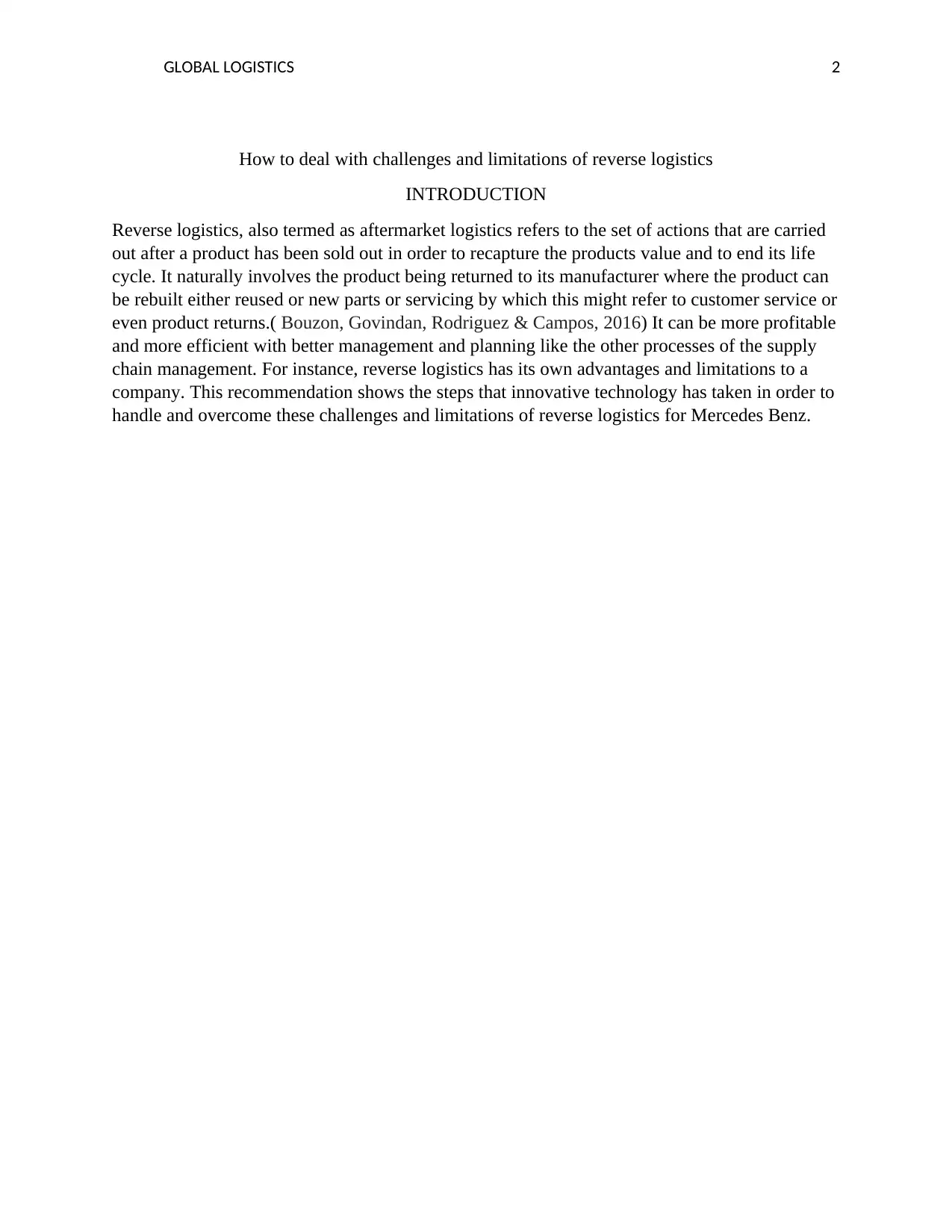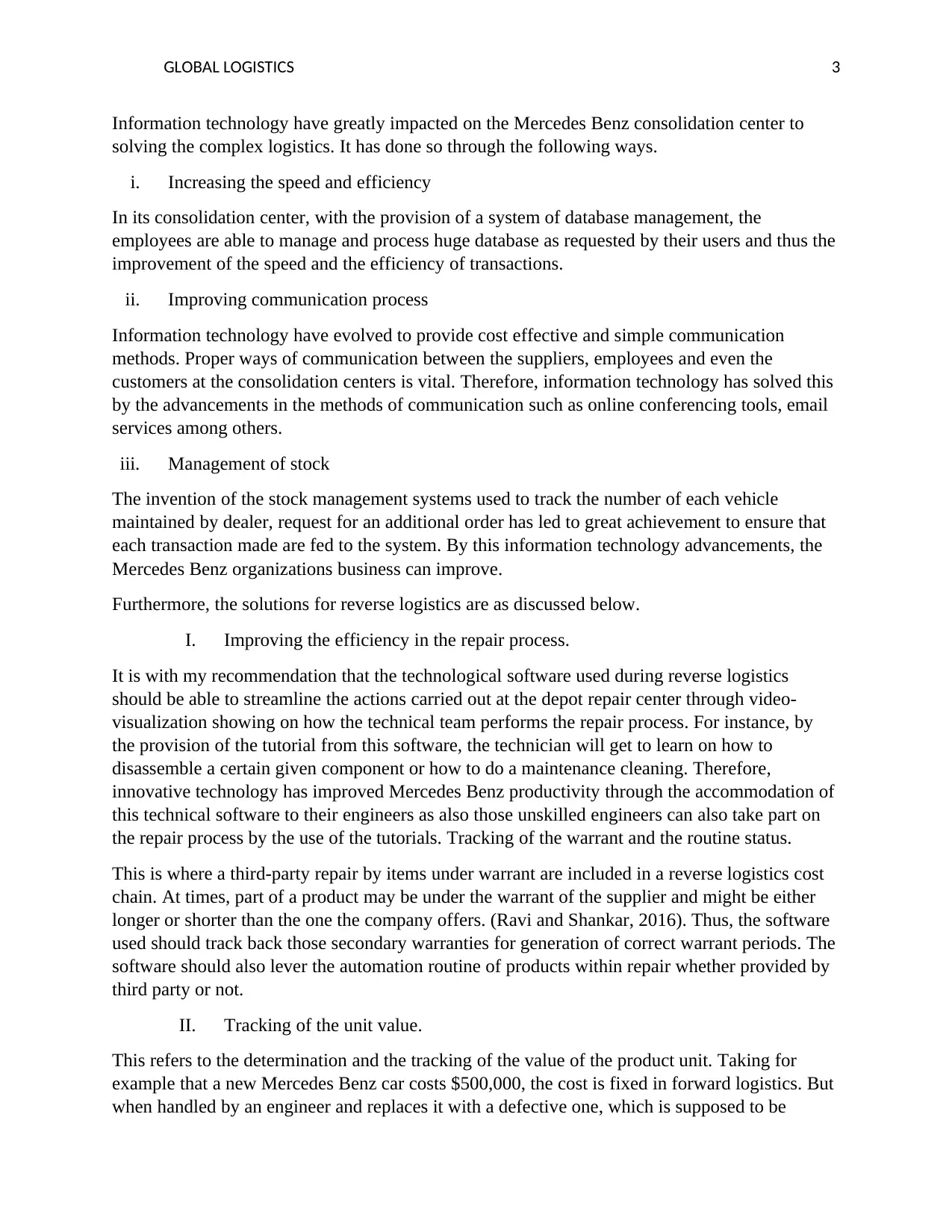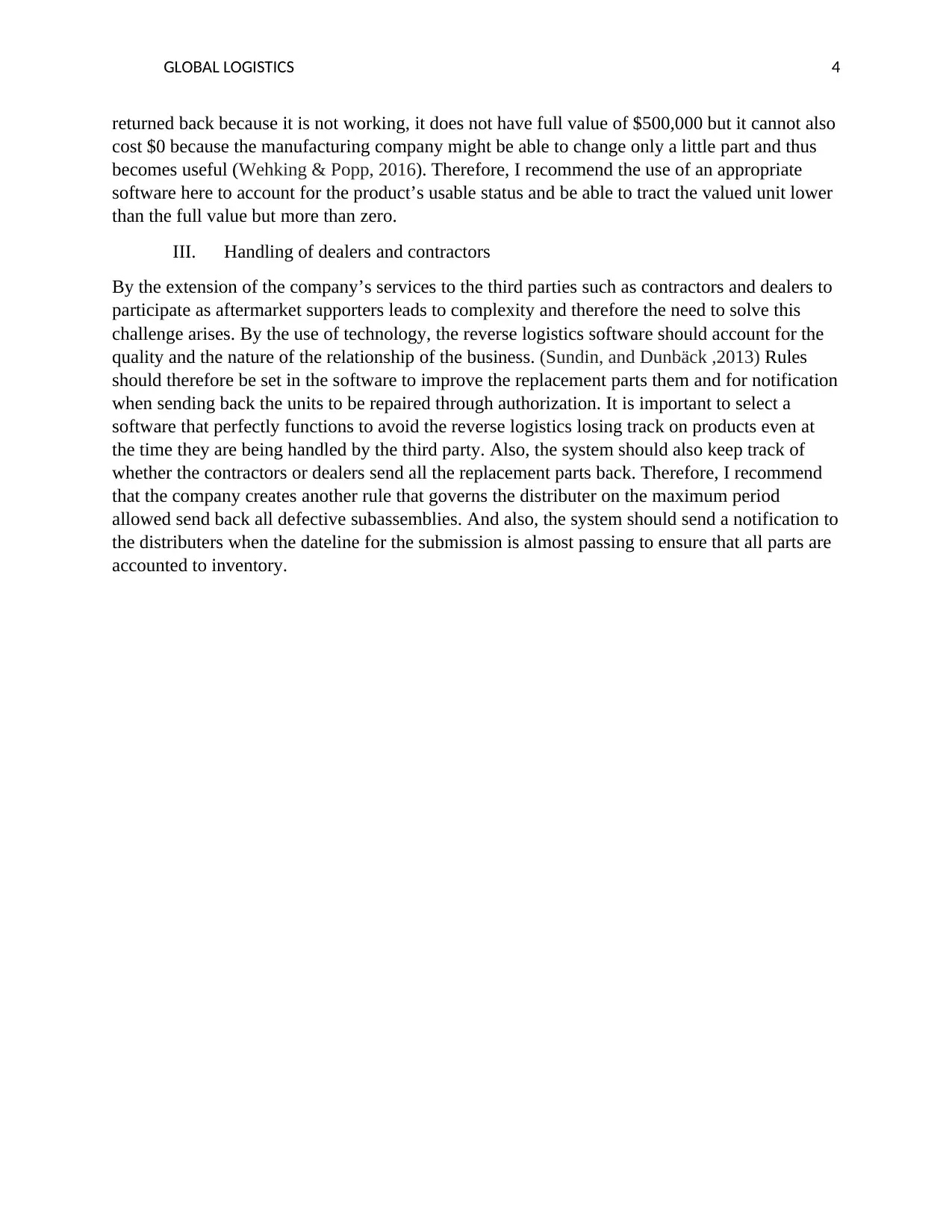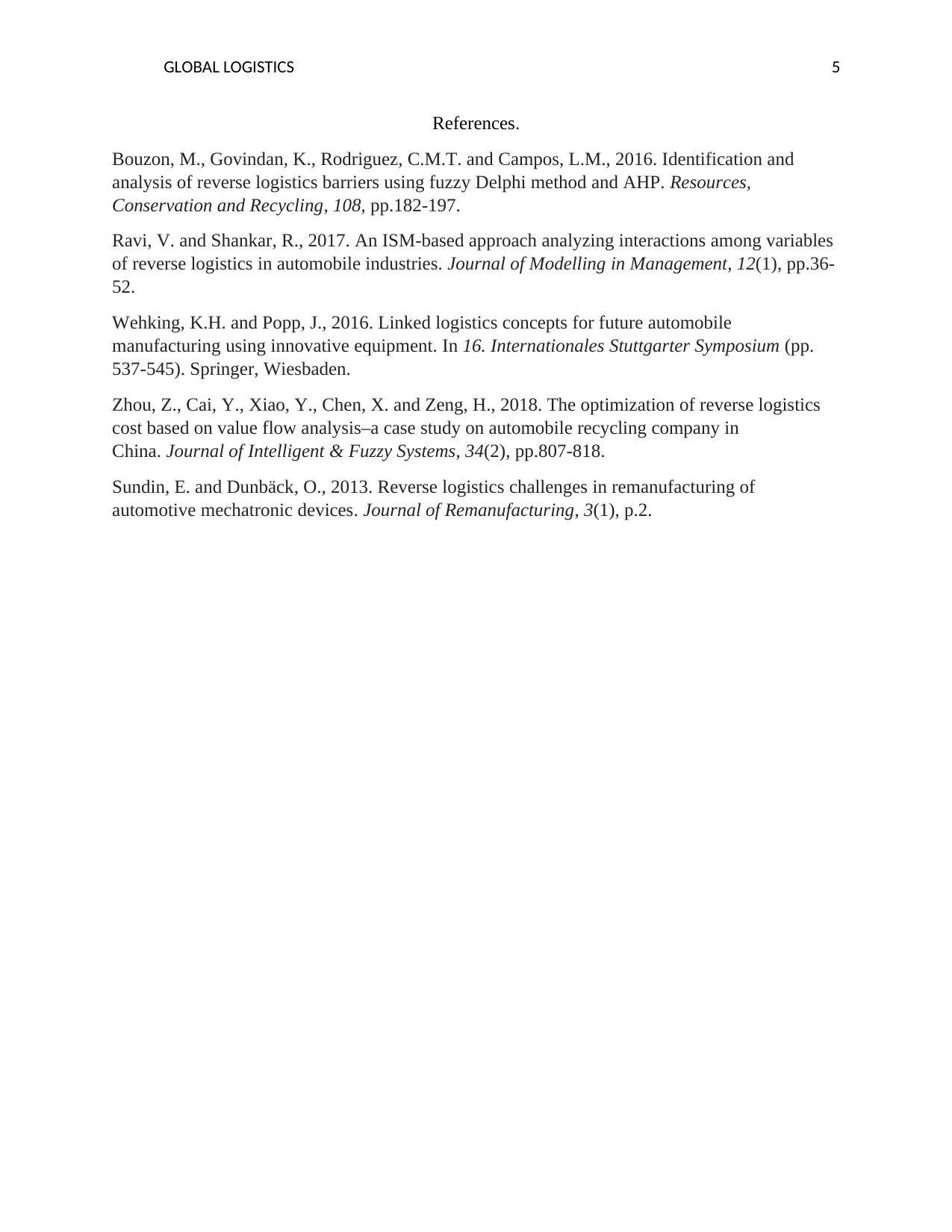Assignment about Global Logistics
VerifiedAdded on 2022/10/01
|5
|1182
|13
Assignment
AI Summary
Contribute Materials
Your contribution can guide someone’s learning journey. Share your
documents today.

GLOBAL LOGISTICS 1
Operations
How to deal with the challenges and limitations of reverse logistics
Name:
Institution:
Date:
Operations
How to deal with the challenges and limitations of reverse logistics
Name:
Institution:
Date:
Secure Best Marks with AI Grader
Need help grading? Try our AI Grader for instant feedback on your assignments.

GLOBAL LOGISTICS 2
How to deal with challenges and limitations of reverse logistics
INTRODUCTION
Reverse logistics, also termed as aftermarket logistics refers to the set of actions that are carried
out after a product has been sold out in order to recapture the products value and to end its life
cycle. It naturally involves the product being returned to its manufacturer where the product can
be rebuilt either reused or new parts or servicing by which this might refer to customer service or
even product returns.( Bouzon, Govindan, Rodriguez & Campos, 2016) It can be more profitable
and more efficient with better management and planning like the other processes of the supply
chain management. For instance, reverse logistics has its own advantages and limitations to a
company. This recommendation shows the steps that innovative technology has taken in order to
handle and overcome these challenges and limitations of reverse logistics for Mercedes Benz.
How to deal with challenges and limitations of reverse logistics
INTRODUCTION
Reverse logistics, also termed as aftermarket logistics refers to the set of actions that are carried
out after a product has been sold out in order to recapture the products value and to end its life
cycle. It naturally involves the product being returned to its manufacturer where the product can
be rebuilt either reused or new parts or servicing by which this might refer to customer service or
even product returns.( Bouzon, Govindan, Rodriguez & Campos, 2016) It can be more profitable
and more efficient with better management and planning like the other processes of the supply
chain management. For instance, reverse logistics has its own advantages and limitations to a
company. This recommendation shows the steps that innovative technology has taken in order to
handle and overcome these challenges and limitations of reverse logistics for Mercedes Benz.

GLOBAL LOGISTICS 3
Information technology have greatly impacted on the Mercedes Benz consolidation center to
solving the complex logistics. It has done so through the following ways.
i. Increasing the speed and efficiency
In its consolidation center, with the provision of a system of database management, the
employees are able to manage and process huge database as requested by their users and thus the
improvement of the speed and the efficiency of transactions.
ii. Improving communication process
Information technology have evolved to provide cost effective and simple communication
methods. Proper ways of communication between the suppliers, employees and even the
customers at the consolidation centers is vital. Therefore, information technology has solved this
by the advancements in the methods of communication such as online conferencing tools, email
services among others.
iii. Management of stock
The invention of the stock management systems used to track the number of each vehicle
maintained by dealer, request for an additional order has led to great achievement to ensure that
each transaction made are fed to the system. By this information technology advancements, the
Mercedes Benz organizations business can improve.
Furthermore, the solutions for reverse logistics are as discussed below.
I. Improving the efficiency in the repair process.
It is with my recommendation that the technological software used during reverse logistics
should be able to streamline the actions carried out at the depot repair center through video-
visualization showing on how the technical team performs the repair process. For instance, by
the provision of the tutorial from this software, the technician will get to learn on how to
disassemble a certain given component or how to do a maintenance cleaning. Therefore,
innovative technology has improved Mercedes Benz productivity through the accommodation of
this technical software to their engineers as also those unskilled engineers can also take part on
the repair process by the use of the tutorials. Tracking of the warrant and the routine status.
This is where a third-party repair by items under warrant are included in a reverse logistics cost
chain. At times, part of a product may be under the warrant of the supplier and might be either
longer or shorter than the one the company offers. (Ravi and Shankar, 2016). Thus, the software
used should track back those secondary warranties for generation of correct warrant periods. The
software should also lever the automation routine of products within repair whether provided by
third party or not.
II. Tracking of the unit value.
This refers to the determination and the tracking of the value of the product unit. Taking for
example that a new Mercedes Benz car costs $500,000, the cost is fixed in forward logistics. But
when handled by an engineer and replaces it with a defective one, which is supposed to be
Information technology have greatly impacted on the Mercedes Benz consolidation center to
solving the complex logistics. It has done so through the following ways.
i. Increasing the speed and efficiency
In its consolidation center, with the provision of a system of database management, the
employees are able to manage and process huge database as requested by their users and thus the
improvement of the speed and the efficiency of transactions.
ii. Improving communication process
Information technology have evolved to provide cost effective and simple communication
methods. Proper ways of communication between the suppliers, employees and even the
customers at the consolidation centers is vital. Therefore, information technology has solved this
by the advancements in the methods of communication such as online conferencing tools, email
services among others.
iii. Management of stock
The invention of the stock management systems used to track the number of each vehicle
maintained by dealer, request for an additional order has led to great achievement to ensure that
each transaction made are fed to the system. By this information technology advancements, the
Mercedes Benz organizations business can improve.
Furthermore, the solutions for reverse logistics are as discussed below.
I. Improving the efficiency in the repair process.
It is with my recommendation that the technological software used during reverse logistics
should be able to streamline the actions carried out at the depot repair center through video-
visualization showing on how the technical team performs the repair process. For instance, by
the provision of the tutorial from this software, the technician will get to learn on how to
disassemble a certain given component or how to do a maintenance cleaning. Therefore,
innovative technology has improved Mercedes Benz productivity through the accommodation of
this technical software to their engineers as also those unskilled engineers can also take part on
the repair process by the use of the tutorials. Tracking of the warrant and the routine status.
This is where a third-party repair by items under warrant are included in a reverse logistics cost
chain. At times, part of a product may be under the warrant of the supplier and might be either
longer or shorter than the one the company offers. (Ravi and Shankar, 2016). Thus, the software
used should track back those secondary warranties for generation of correct warrant periods. The
software should also lever the automation routine of products within repair whether provided by
third party or not.
II. Tracking of the unit value.
This refers to the determination and the tracking of the value of the product unit. Taking for
example that a new Mercedes Benz car costs $500,000, the cost is fixed in forward logistics. But
when handled by an engineer and replaces it with a defective one, which is supposed to be

GLOBAL LOGISTICS 4
returned back because it is not working, it does not have full value of $500,000 but it cannot also
cost $0 because the manufacturing company might be able to change only a little part and thus
becomes useful (Wehking & Popp, 2016). Therefore, I recommend the use of an appropriate
software here to account for the product’s usable status and be able to tract the valued unit lower
than the full value but more than zero.
III. Handling of dealers and contractors
By the extension of the company’s services to the third parties such as contractors and dealers to
participate as aftermarket supporters leads to complexity and therefore the need to solve this
challenge arises. By the use of technology, the reverse logistics software should account for the
quality and the nature of the relationship of the business. (Sundin, and Dunbäck ,2013) Rules
should therefore be set in the software to improve the replacement parts them and for notification
when sending back the units to be repaired through authorization. It is important to select a
software that perfectly functions to avoid the reverse logistics losing track on products even at
the time they are being handled by the third party. Also, the system should also keep track of
whether the contractors or dealers send all the replacement parts back. Therefore, I recommend
that the company creates another rule that governs the distributer on the maximum period
allowed send back all defective subassemblies. And also, the system should send a notification to
the distributers when the dateline for the submission is almost passing to ensure that all parts are
accounted to inventory.
returned back because it is not working, it does not have full value of $500,000 but it cannot also
cost $0 because the manufacturing company might be able to change only a little part and thus
becomes useful (Wehking & Popp, 2016). Therefore, I recommend the use of an appropriate
software here to account for the product’s usable status and be able to tract the valued unit lower
than the full value but more than zero.
III. Handling of dealers and contractors
By the extension of the company’s services to the third parties such as contractors and dealers to
participate as aftermarket supporters leads to complexity and therefore the need to solve this
challenge arises. By the use of technology, the reverse logistics software should account for the
quality and the nature of the relationship of the business. (Sundin, and Dunbäck ,2013) Rules
should therefore be set in the software to improve the replacement parts them and for notification
when sending back the units to be repaired through authorization. It is important to select a
software that perfectly functions to avoid the reverse logistics losing track on products even at
the time they are being handled by the third party. Also, the system should also keep track of
whether the contractors or dealers send all the replacement parts back. Therefore, I recommend
that the company creates another rule that governs the distributer on the maximum period
allowed send back all defective subassemblies. And also, the system should send a notification to
the distributers when the dateline for the submission is almost passing to ensure that all parts are
accounted to inventory.
Secure Best Marks with AI Grader
Need help grading? Try our AI Grader for instant feedback on your assignments.

GLOBAL LOGISTICS 5
References.
Bouzon, M., Govindan, K., Rodriguez, C.M.T. and Campos, L.M., 2016. Identification and
analysis of reverse logistics barriers using fuzzy Delphi method and AHP. Resources,
Conservation and Recycling, 108, pp.182-197.
Ravi, V. and Shankar, R., 2017. An ISM-based approach analyzing interactions among variables
of reverse logistics in automobile industries. Journal of Modelling in Management, 12(1), pp.36-
52.
Wehking, K.H. and Popp, J., 2016. Linked logistics concepts for future automobile
manufacturing using innovative equipment. In 16. Internationales Stuttgarter Symposium (pp.
537-545). Springer, Wiesbaden.
Zhou, Z., Cai, Y., Xiao, Y., Chen, X. and Zeng, H., 2018. The optimization of reverse logistics
cost based on value flow analysis–a case study on automobile recycling company in
China. Journal of Intelligent & Fuzzy Systems, 34(2), pp.807-818.
Sundin, E. and Dunbäck, O., 2013. Reverse logistics challenges in remanufacturing of
automotive mechatronic devices. Journal of Remanufacturing, 3(1), p.2.
References.
Bouzon, M., Govindan, K., Rodriguez, C.M.T. and Campos, L.M., 2016. Identification and
analysis of reverse logistics barriers using fuzzy Delphi method and AHP. Resources,
Conservation and Recycling, 108, pp.182-197.
Ravi, V. and Shankar, R., 2017. An ISM-based approach analyzing interactions among variables
of reverse logistics in automobile industries. Journal of Modelling in Management, 12(1), pp.36-
52.
Wehking, K.H. and Popp, J., 2016. Linked logistics concepts for future automobile
manufacturing using innovative equipment. In 16. Internationales Stuttgarter Symposium (pp.
537-545). Springer, Wiesbaden.
Zhou, Z., Cai, Y., Xiao, Y., Chen, X. and Zeng, H., 2018. The optimization of reverse logistics
cost based on value flow analysis–a case study on automobile recycling company in
China. Journal of Intelligent & Fuzzy Systems, 34(2), pp.807-818.
Sundin, E. and Dunbäck, O., 2013. Reverse logistics challenges in remanufacturing of
automotive mechatronic devices. Journal of Remanufacturing, 3(1), p.2.
1 out of 5
Related Documents
Your All-in-One AI-Powered Toolkit for Academic Success.
+13062052269
info@desklib.com
Available 24*7 on WhatsApp / Email
![[object Object]](/_next/static/media/star-bottom.7253800d.svg)
Unlock your academic potential
© 2024 | Zucol Services PVT LTD | All rights reserved.




